ENGT5261 Building Performance Modelling: Office Building Analysis
VerifiedAdded on 2022/08/21
|20
|2047
|21
Report
AI Summary
This report provides an assessment of an office building's performance through building performance modelling, addressing the ENGT5261 module requirements. The study investigates thermal comfort, energy efficiency, and indoor environmental quality by analyzing the impact of various design modifications. These modifications include color changes, insulation removal, glazing changes, building rotation, solar shade additions, door material changes, fly roof implementation, and window location adjustments. The report benchmarks the initial model and compares it against scenarios with implemented changes, evaluating the energy demand for heating and cooling. Ultimately, the report recommends strategies such as window location changes, solar shade additions, and air cavity removal to enhance building design and reduce energy consumption, while maintaining indoor environmental quality. The client is advised to consider these strategies to optimize building performance and thermal comfort.
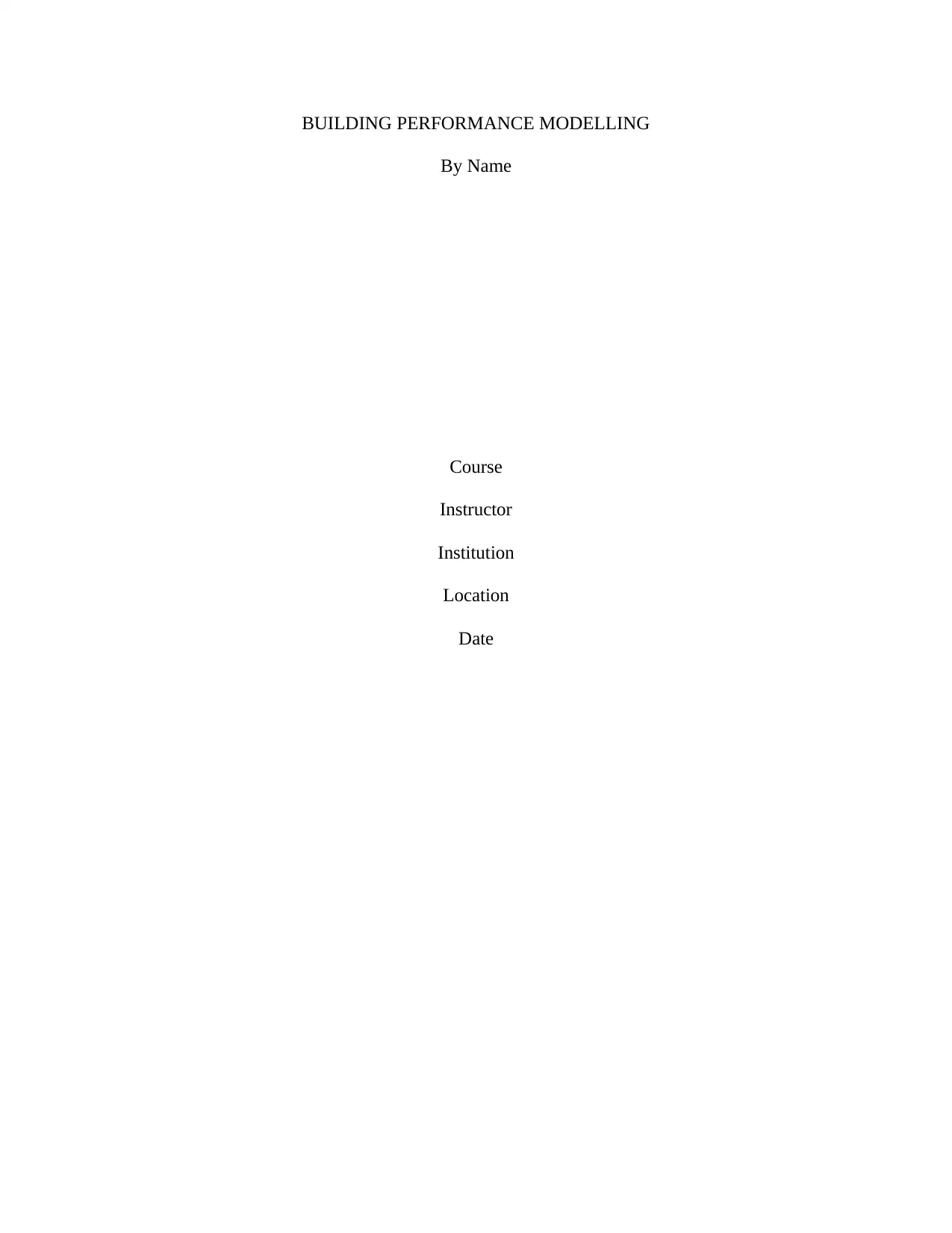
BUILDING PERFORMANCE MODELLING
By Name
Course
Instructor
Institution
Location
Date
By Name
Course
Instructor
Institution
Location
Date
Paraphrase This Document
Need a fresh take? Get an instant paraphrase of this document with our AI Paraphraser
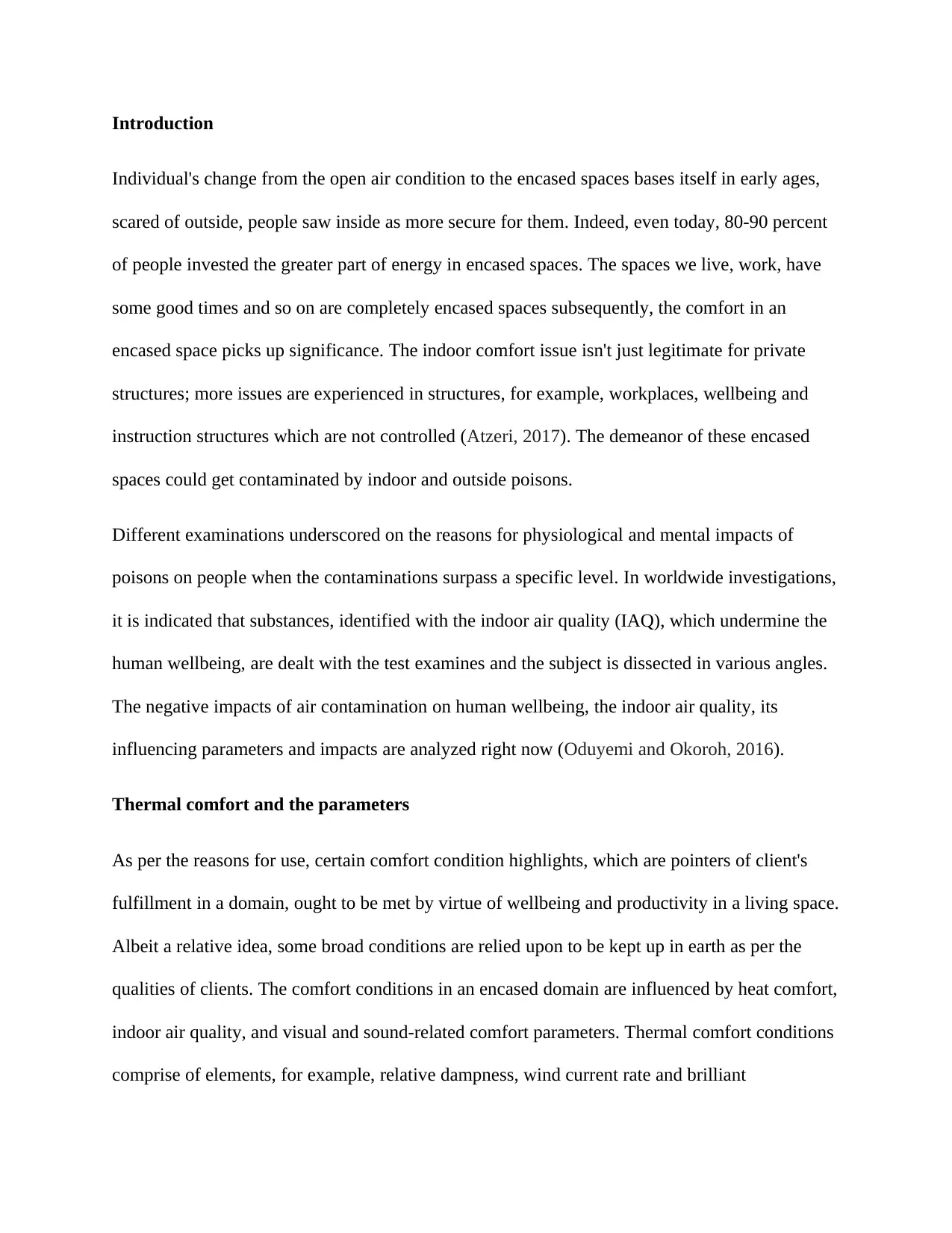
Introduction
Individual's change from the open air condition to the encased spaces bases itself in early ages,
scared of outside, people saw inside as more secure for them. Indeed, even today, 80-90 percent
of people invested the greater part of energy in encased spaces. The spaces we live, work, have
some good times and so on are completely encased spaces subsequently, the comfort in an
encased space picks up significance. The indoor comfort issue isn't just legitimate for private
structures; more issues are experienced in structures, for example, workplaces, wellbeing and
instruction structures which are not controlled (Atzeri, 2017). The demeanor of these encased
spaces could get contaminated by indoor and outside poisons.
Different examinations underscored on the reasons for physiological and mental impacts of
poisons on people when the contaminations surpass a specific level. In worldwide investigations,
it is indicated that substances, identified with the indoor air quality (IAQ), which undermine the
human wellbeing, are dealt with the test examines and the subject is dissected in various angles.
The negative impacts of air contamination on human wellbeing, the indoor air quality, its
influencing parameters and impacts are analyzed right now (Oduyemi and Okoroh, 2016).
Thermal comfort and the parameters
As per the reasons for use, certain comfort condition highlights, which are pointers of client's
fulfillment in a domain, ought to be met by virtue of wellbeing and productivity in a living space.
Albeit a relative idea, some broad conditions are relied upon to be kept up in earth as per the
qualities of clients. The comfort conditions in an encased domain are influenced by heat comfort,
indoor air quality, and visual and sound-related comfort parameters. Thermal comfort conditions
comprise of elements, for example, relative dampness, wind current rate and brilliant
Individual's change from the open air condition to the encased spaces bases itself in early ages,
scared of outside, people saw inside as more secure for them. Indeed, even today, 80-90 percent
of people invested the greater part of energy in encased spaces. The spaces we live, work, have
some good times and so on are completely encased spaces subsequently, the comfort in an
encased space picks up significance. The indoor comfort issue isn't just legitimate for private
structures; more issues are experienced in structures, for example, workplaces, wellbeing and
instruction structures which are not controlled (Atzeri, 2017). The demeanor of these encased
spaces could get contaminated by indoor and outside poisons.
Different examinations underscored on the reasons for physiological and mental impacts of
poisons on people when the contaminations surpass a specific level. In worldwide investigations,
it is indicated that substances, identified with the indoor air quality (IAQ), which undermine the
human wellbeing, are dealt with the test examines and the subject is dissected in various angles.
The negative impacts of air contamination on human wellbeing, the indoor air quality, its
influencing parameters and impacts are analyzed right now (Oduyemi and Okoroh, 2016).
Thermal comfort and the parameters
As per the reasons for use, certain comfort condition highlights, which are pointers of client's
fulfillment in a domain, ought to be met by virtue of wellbeing and productivity in a living space.
Albeit a relative idea, some broad conditions are relied upon to be kept up in earth as per the
qualities of clients. The comfort conditions in an encased domain are influenced by heat comfort,
indoor air quality, and visual and sound-related comfort parameters. Thermal comfort conditions
comprise of elements, for example, relative dampness, wind current rate and brilliant
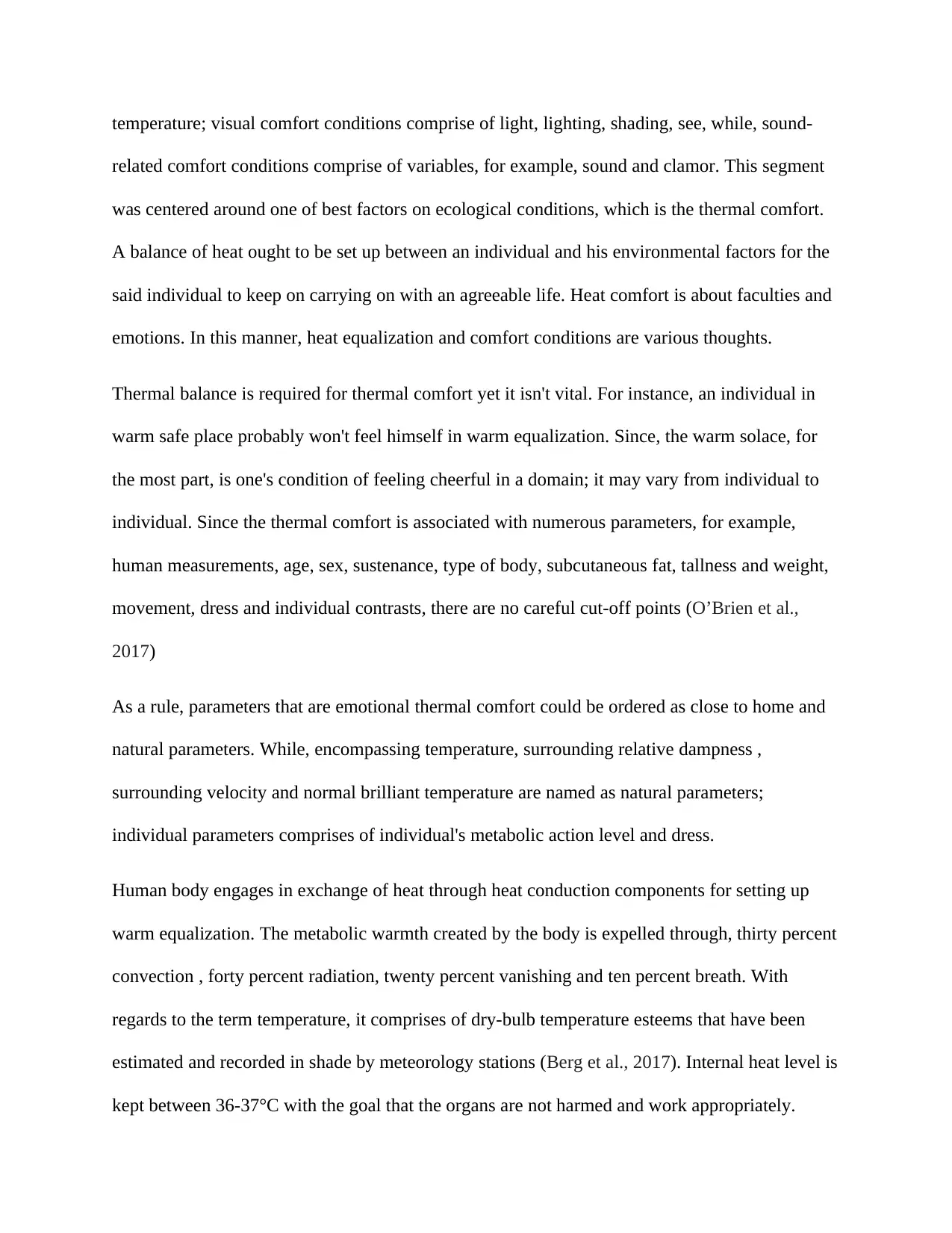
temperature; visual comfort conditions comprise of light, lighting, shading, see, while, sound-
related comfort conditions comprise of variables, for example, sound and clamor. This segment
was centered around one of best factors on ecological conditions, which is the thermal comfort.
A balance of heat ought to be set up between an individual and his environmental factors for the
said individual to keep on carrying on with an agreeable life. Heat comfort is about faculties and
emotions. In this manner, heat equalization and comfort conditions are various thoughts.
Thermal balance is required for thermal comfort yet it isn't vital. For instance, an individual in
warm safe place probably won't feel himself in warm equalization. Since, the warm solace, for
the most part, is one's condition of feeling cheerful in a domain; it may vary from individual to
individual. Since the thermal comfort is associated with numerous parameters, for example,
human measurements, age, sex, sustenance, type of body, subcutaneous fat, tallness and weight,
movement, dress and individual contrasts, there are no careful cut-off points (O’Brien et al.,
2017)
As a rule, parameters that are emotional thermal comfort could be ordered as close to home and
natural parameters. While, encompassing temperature, surrounding relative dampness ,
surrounding velocity and normal brilliant temperature are named as natural parameters;
individual parameters comprises of individual's metabolic action level and dress.
Human body engages in exchange of heat through heat conduction components for setting up
warm equalization. The metabolic warmth created by the body is expelled through, thirty percent
convection , forty percent radiation, twenty percent vanishing and ten percent breath. With
regards to the term temperature, it comprises of dry-bulb temperature esteems that have been
estimated and recorded in shade by meteorology stations (Berg et al., 2017). Internal heat level is
kept between 36-37°C with the goal that the organs are not harmed and work appropriately.
related comfort conditions comprise of variables, for example, sound and clamor. This segment
was centered around one of best factors on ecological conditions, which is the thermal comfort.
A balance of heat ought to be set up between an individual and his environmental factors for the
said individual to keep on carrying on with an agreeable life. Heat comfort is about faculties and
emotions. In this manner, heat equalization and comfort conditions are various thoughts.
Thermal balance is required for thermal comfort yet it isn't vital. For instance, an individual in
warm safe place probably won't feel himself in warm equalization. Since, the warm solace, for
the most part, is one's condition of feeling cheerful in a domain; it may vary from individual to
individual. Since the thermal comfort is associated with numerous parameters, for example,
human measurements, age, sex, sustenance, type of body, subcutaneous fat, tallness and weight,
movement, dress and individual contrasts, there are no careful cut-off points (O’Brien et al.,
2017)
As a rule, parameters that are emotional thermal comfort could be ordered as close to home and
natural parameters. While, encompassing temperature, surrounding relative dampness ,
surrounding velocity and normal brilliant temperature are named as natural parameters;
individual parameters comprises of individual's metabolic action level and dress.
Human body engages in exchange of heat through heat conduction components for setting up
warm equalization. The metabolic warmth created by the body is expelled through, thirty percent
convection , forty percent radiation, twenty percent vanishing and ten percent breath. With
regards to the term temperature, it comprises of dry-bulb temperature esteems that have been
estimated and recorded in shade by meteorology stations (Berg et al., 2017). Internal heat level is
kept between 36-37°C with the goal that the organs are not harmed and work appropriately.
⊘ This is a preview!⊘
Do you want full access?
Subscribe today to unlock all pages.

Trusted by 1+ million students worldwide
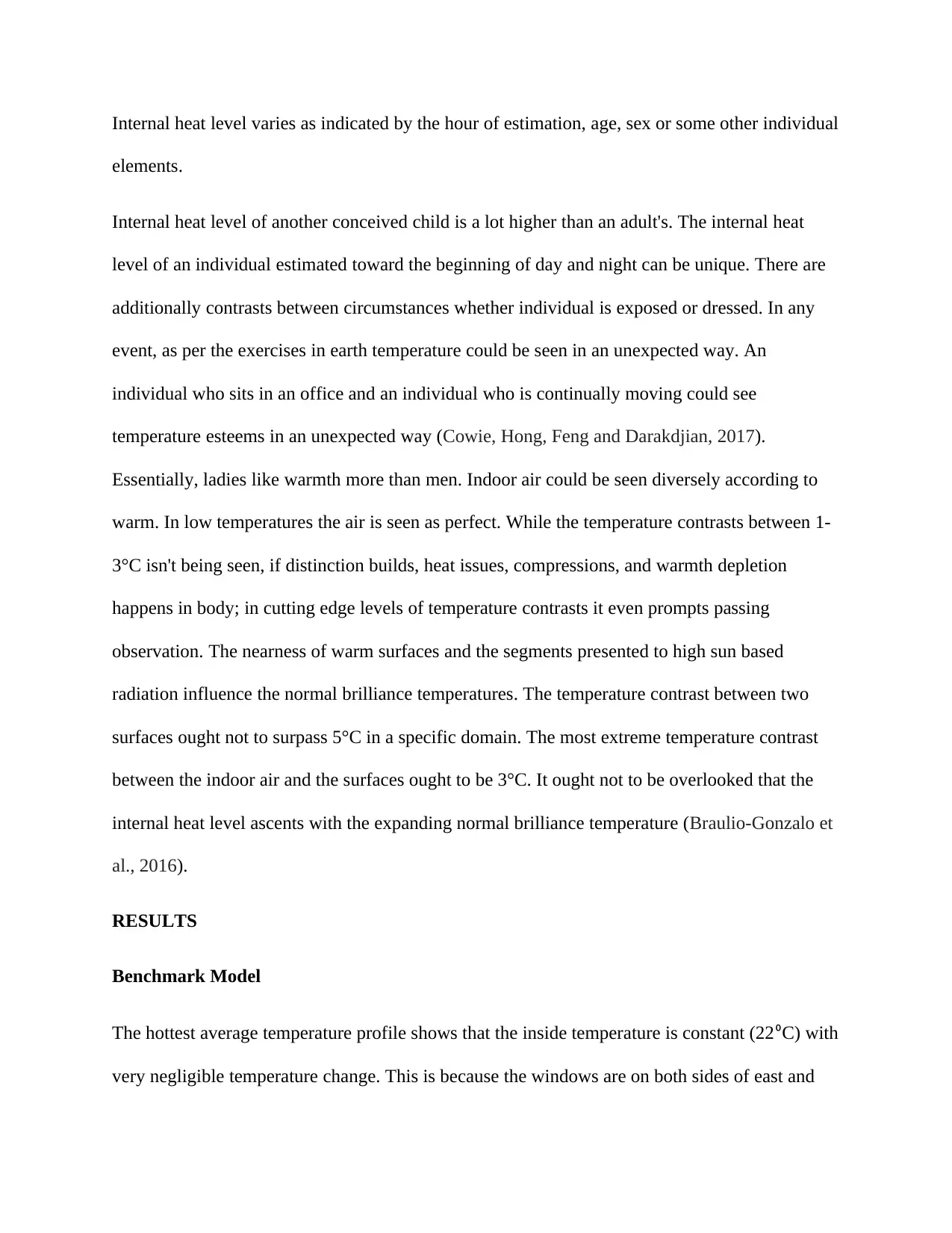
Internal heat level varies as indicated by the hour of estimation, age, sex or some other individual
elements.
Internal heat level of another conceived child is a lot higher than an adult's. The internal heat
level of an individual estimated toward the beginning of day and night can be unique. There are
additionally contrasts between circumstances whether individual is exposed or dressed. In any
event, as per the exercises in earth temperature could be seen in an unexpected way. An
individual who sits in an office and an individual who is continually moving could see
temperature esteems in an unexpected way (Cowie, Hong, Feng and Darakdjian, 2017).
Essentially, ladies like warmth more than men. Indoor air could be seen diversely according to
warm. In low temperatures the air is seen as perfect. While the temperature contrasts between 1-
3°C isn't being seen, if distinction builds, heat issues, compressions, and warmth depletion
happens in body; in cutting edge levels of temperature contrasts it even prompts passing
observation. The nearness of warm surfaces and the segments presented to high sun based
radiation influence the normal brilliance temperatures. The temperature contrast between two
surfaces ought not to surpass 5°C in a specific domain. The most extreme temperature contrast
between the indoor air and the surfaces ought to be 3°C. It ought not to be overlooked that the
internal heat level ascents with the expanding normal brilliance temperature (Braulio-Gonzalo et
al., 2016).
RESULTS
Benchmark Model
The hottest average temperature profile shows that the inside temperature is constant (22⁰C) with
very negligible temperature change. This is because the windows are on both sides of east and
elements.
Internal heat level of another conceived child is a lot higher than an adult's. The internal heat
level of an individual estimated toward the beginning of day and night can be unique. There are
additionally contrasts between circumstances whether individual is exposed or dressed. In any
event, as per the exercises in earth temperature could be seen in an unexpected way. An
individual who sits in an office and an individual who is continually moving could see
temperature esteems in an unexpected way (Cowie, Hong, Feng and Darakdjian, 2017).
Essentially, ladies like warmth more than men. Indoor air could be seen diversely according to
warm. In low temperatures the air is seen as perfect. While the temperature contrasts between 1-
3°C isn't being seen, if distinction builds, heat issues, compressions, and warmth depletion
happens in body; in cutting edge levels of temperature contrasts it even prompts passing
observation. The nearness of warm surfaces and the segments presented to high sun based
radiation influence the normal brilliance temperatures. The temperature contrast between two
surfaces ought not to surpass 5°C in a specific domain. The most extreme temperature contrast
between the indoor air and the surfaces ought to be 3°C. It ought not to be overlooked that the
internal heat level ascents with the expanding normal brilliance temperature (Braulio-Gonzalo et
al., 2016).
RESULTS
Benchmark Model
The hottest average temperature profile shows that the inside temperature is constant (22⁰C) with
very negligible temperature change. This is because the windows are on both sides of east and
Paraphrase This Document
Need a fresh take? Get an instant paraphrase of this document with our AI Paraphraser
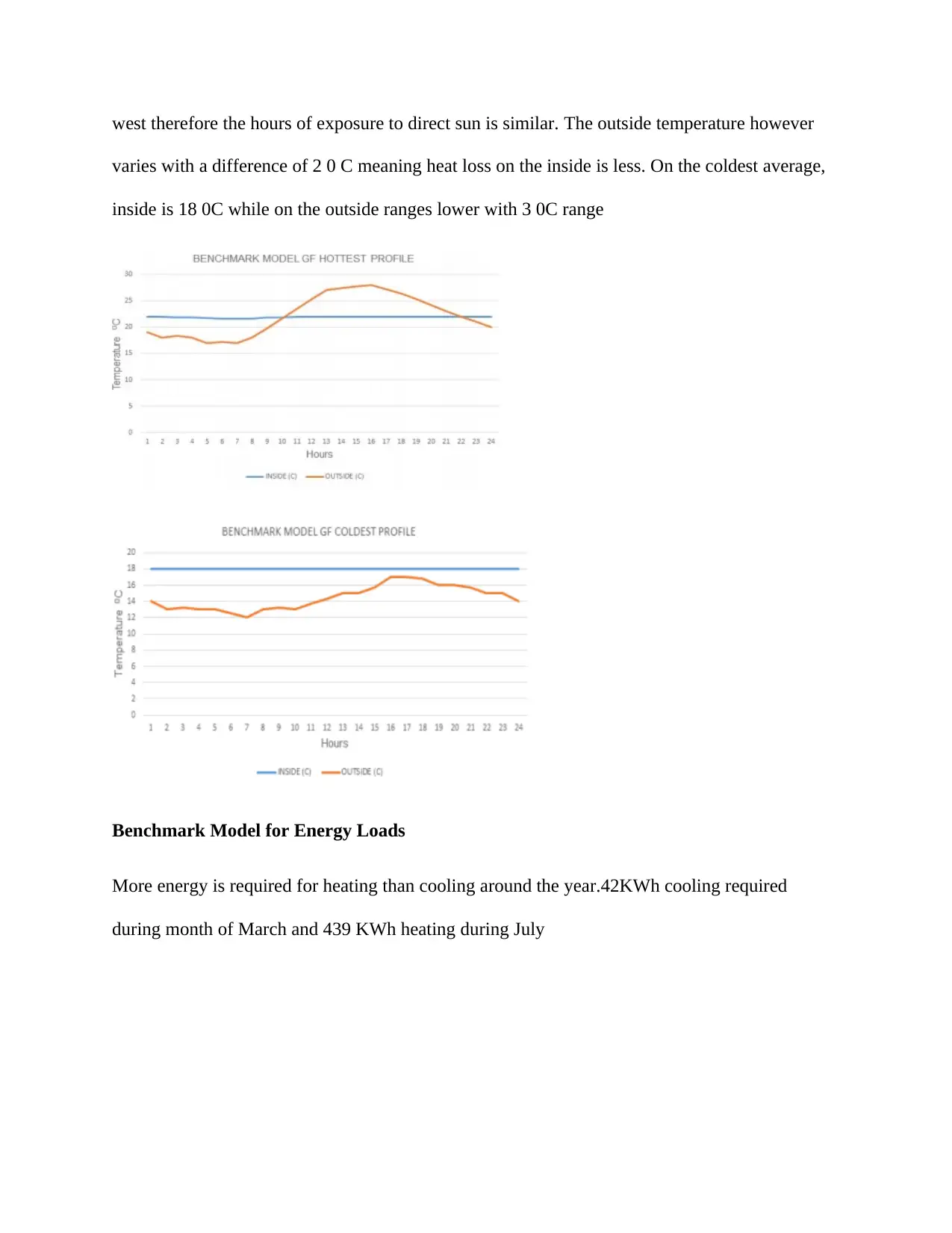
west therefore the hours of exposure to direct sun is similar. The outside temperature however
varies with a difference of 2 0 C meaning heat loss on the inside is less. On the coldest average,
inside is 18 0C while on the outside ranges lower with 3 0C range
Benchmark Model for Energy Loads
More energy is required for heating than cooling around the year.42KWh cooling required
during month of March and 439 KWh heating during July
varies with a difference of 2 0 C meaning heat loss on the inside is less. On the coldest average,
inside is 18 0C while on the outside ranges lower with 3 0C range
Benchmark Model for Energy Loads
More energy is required for heating than cooling around the year.42KWh cooling required
during month of March and 439 KWh heating during July
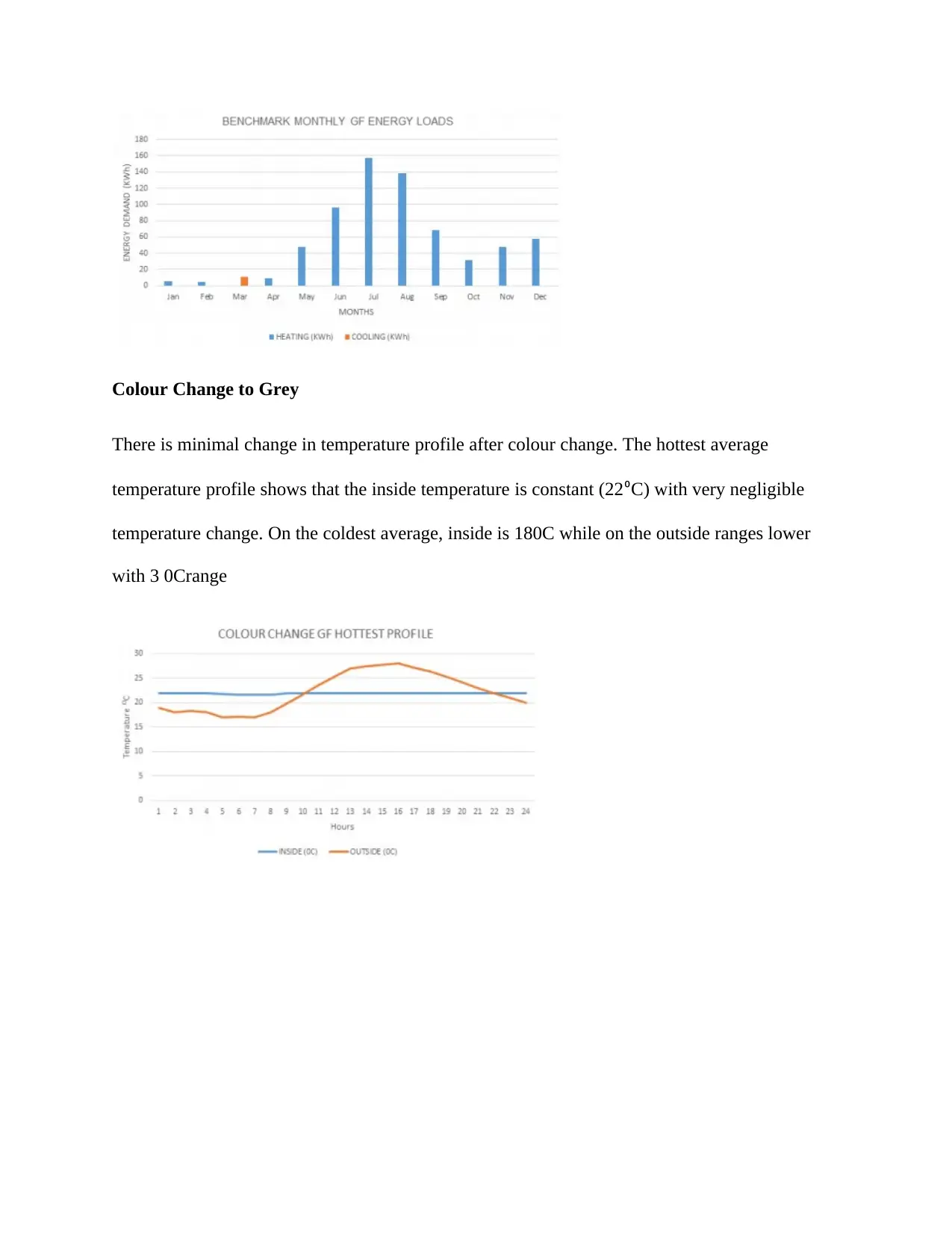
Colour Change to Grey
There is minimal change in temperature profile after colour change. The hottest average
temperature profile shows that the inside temperature is constant (22⁰C) with very negligible
temperature change. On the coldest average, inside is 180C while on the outside ranges lower
with 3 0Crange
There is minimal change in temperature profile after colour change. The hottest average
temperature profile shows that the inside temperature is constant (22⁰C) with very negligible
temperature change. On the coldest average, inside is 180C while on the outside ranges lower
with 3 0Crange
⊘ This is a preview!⊘
Do you want full access?
Subscribe today to unlock all pages.

Trusted by 1+ million students worldwide
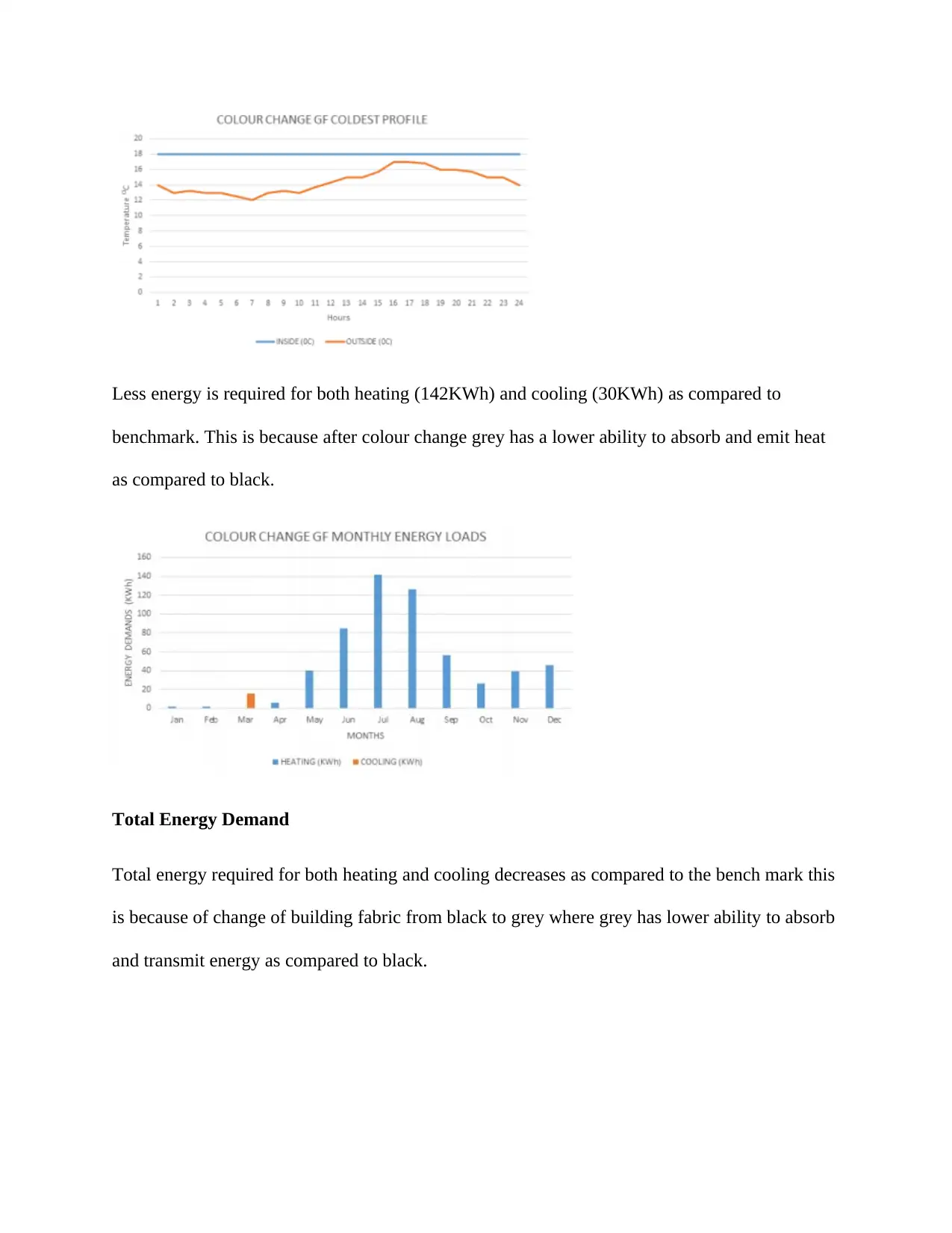
Less energy is required for both heating (142KWh) and cooling (30KWh) as compared to
benchmark. This is because after colour change grey has a lower ability to absorb and emit heat
as compared to black.
Total Energy Demand
Total energy required for both heating and cooling decreases as compared to the bench mark this
is because of change of building fabric from black to grey where grey has lower ability to absorb
and transmit energy as compared to black.
benchmark. This is because after colour change grey has a lower ability to absorb and emit heat
as compared to black.
Total Energy Demand
Total energy required for both heating and cooling decreases as compared to the bench mark this
is because of change of building fabric from black to grey where grey has lower ability to absorb
and transmit energy as compared to black.
Paraphrase This Document
Need a fresh take? Get an instant paraphrase of this document with our AI Paraphraser
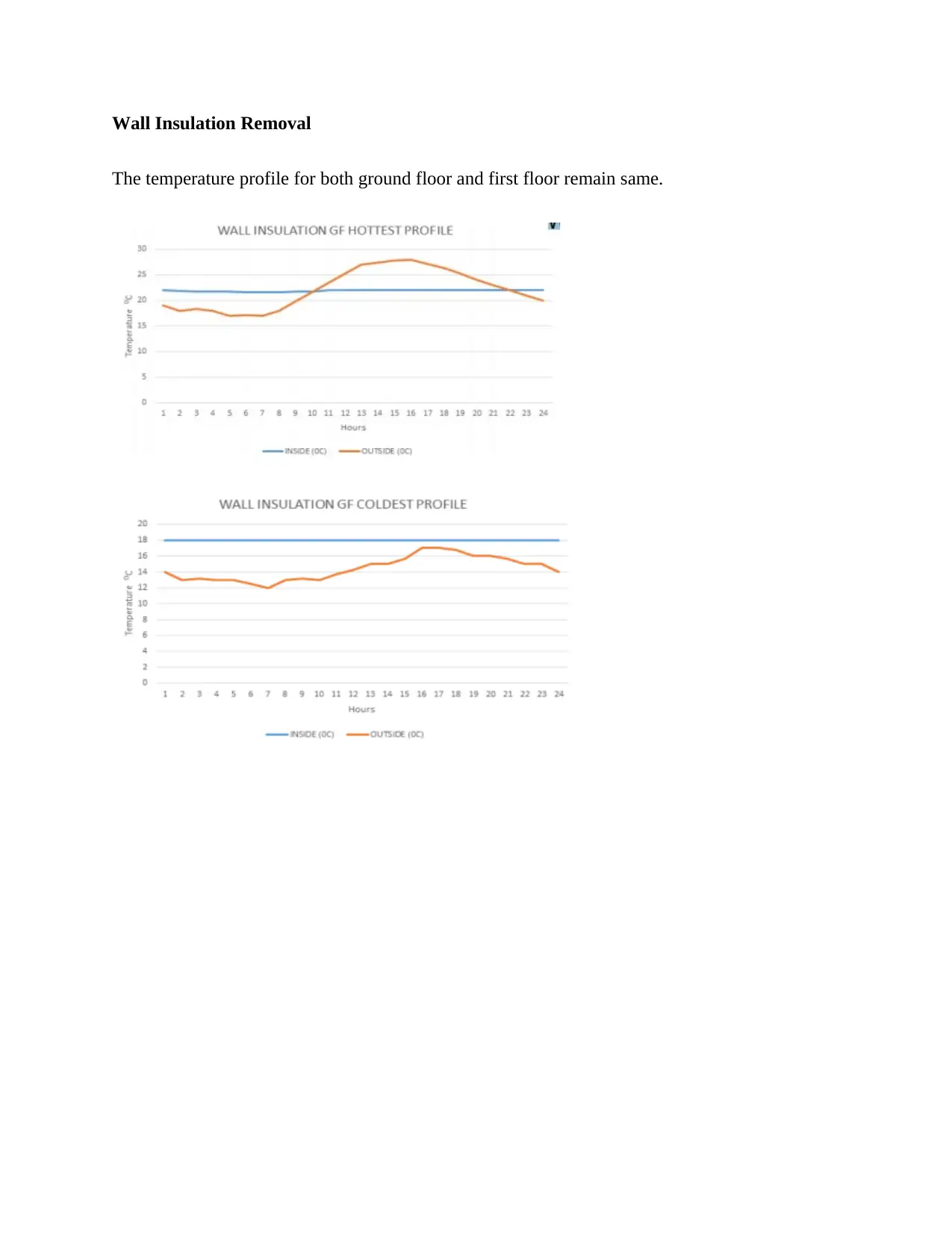
Wall Insulation Removal
The temperature profile for both ground floor and first floor remain same.
The temperature profile for both ground floor and first floor remain same.
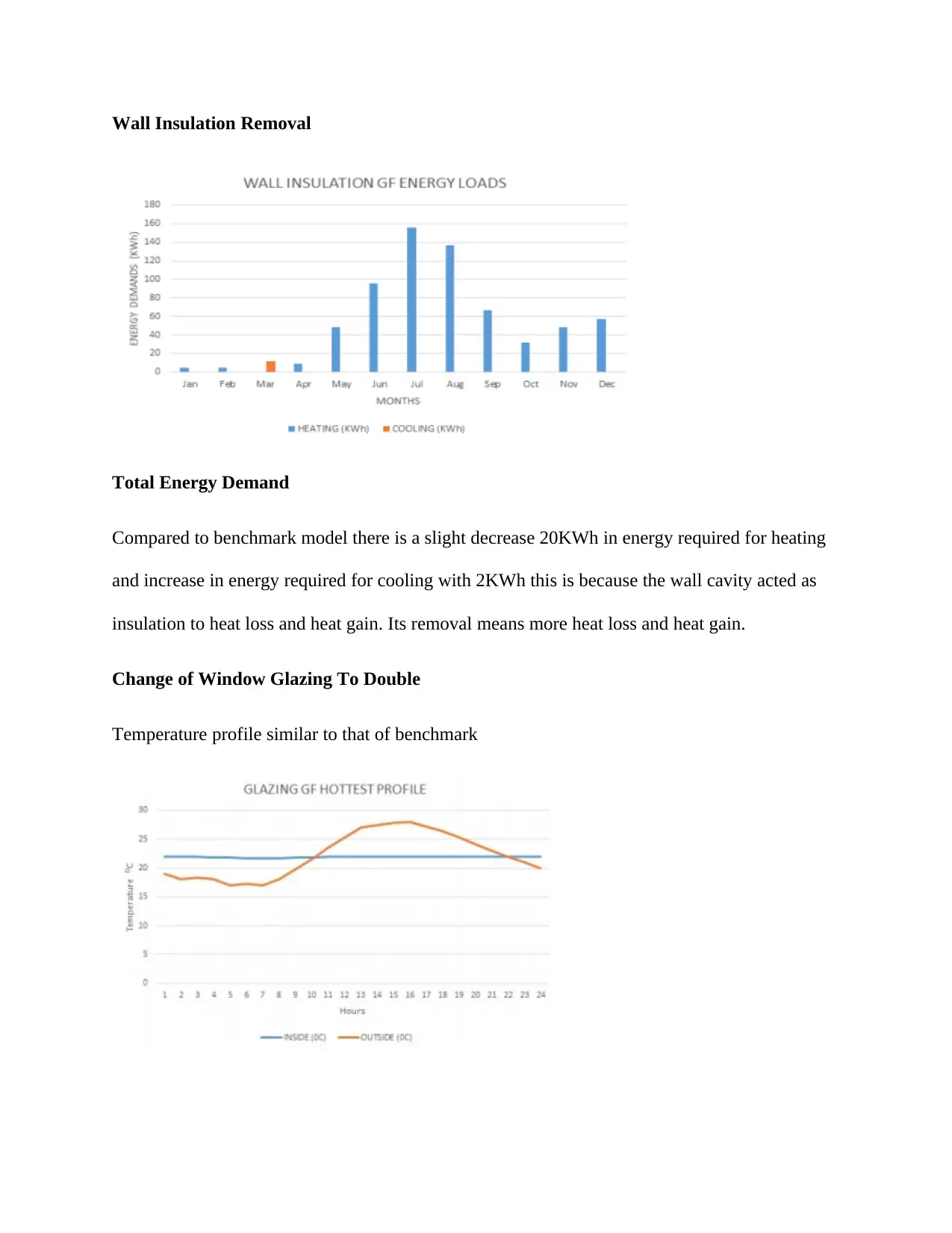
Wall Insulation Removal
Total Energy Demand
Compared to benchmark model there is a slight decrease 20KWh in energy required for heating
and increase in energy required for cooling with 2KWh this is because the wall cavity acted as
insulation to heat loss and heat gain. Its removal means more heat loss and heat gain.
Change of Window Glazing To Double
Temperature profile similar to that of benchmark
Total Energy Demand
Compared to benchmark model there is a slight decrease 20KWh in energy required for heating
and increase in energy required for cooling with 2KWh this is because the wall cavity acted as
insulation to heat loss and heat gain. Its removal means more heat loss and heat gain.
Change of Window Glazing To Double
Temperature profile similar to that of benchmark
⊘ This is a preview!⊘
Do you want full access?
Subscribe today to unlock all pages.

Trusted by 1+ million students worldwide
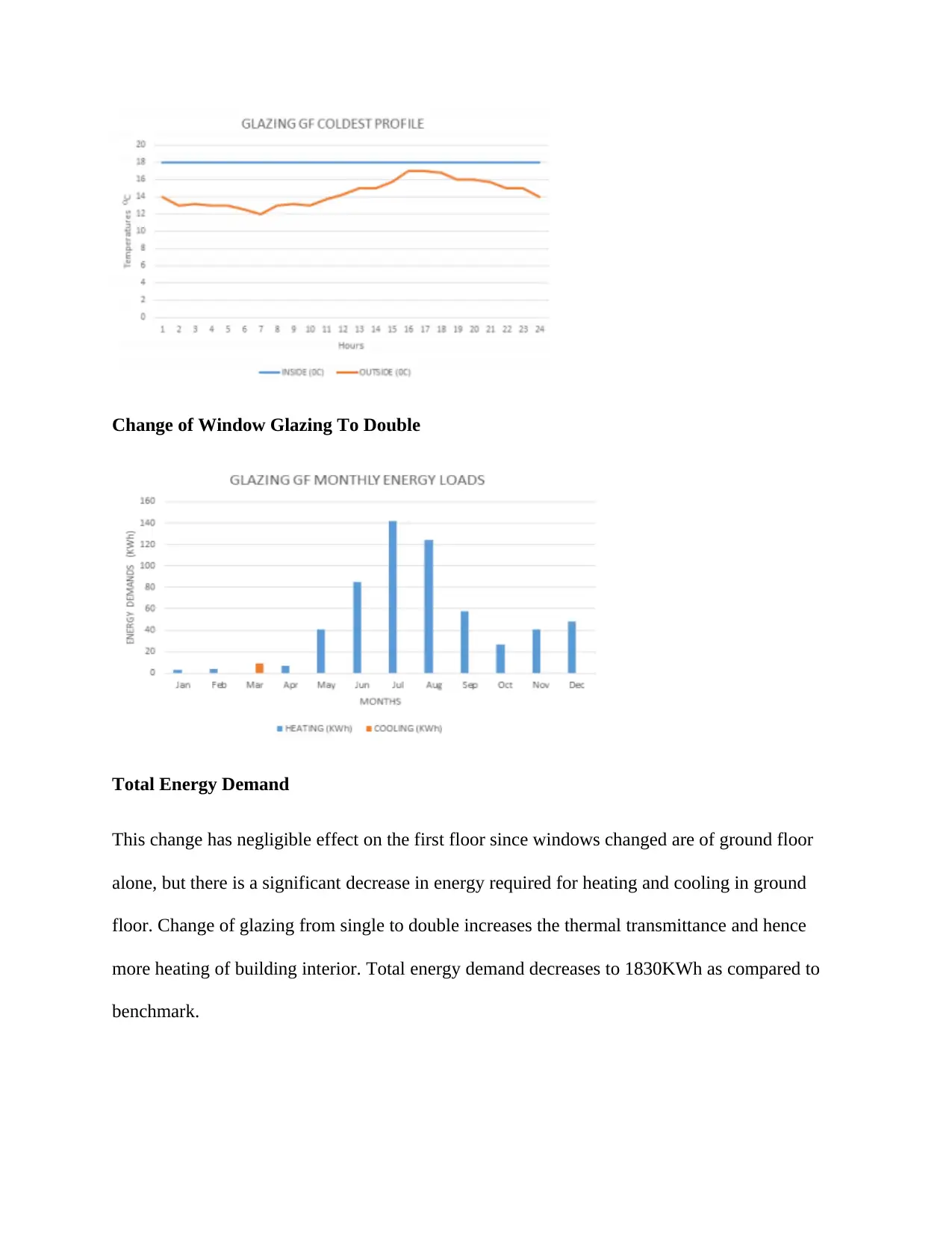
Change of Window Glazing To Double
Total Energy Demand
This change has negligible effect on the first floor since windows changed are of ground floor
alone, but there is a significant decrease in energy required for heating and cooling in ground
floor. Change of glazing from single to double increases the thermal transmittance and hence
more heating of building interior. Total energy demand decreases to 1830KWh as compared to
benchmark.
Total Energy Demand
This change has negligible effect on the first floor since windows changed are of ground floor
alone, but there is a significant decrease in energy required for heating and cooling in ground
floor. Change of glazing from single to double increases the thermal transmittance and hence
more heating of building interior. Total energy demand decreases to 1830KWh as compared to
benchmark.
Paraphrase This Document
Need a fresh take? Get an instant paraphrase of this document with our AI Paraphraser
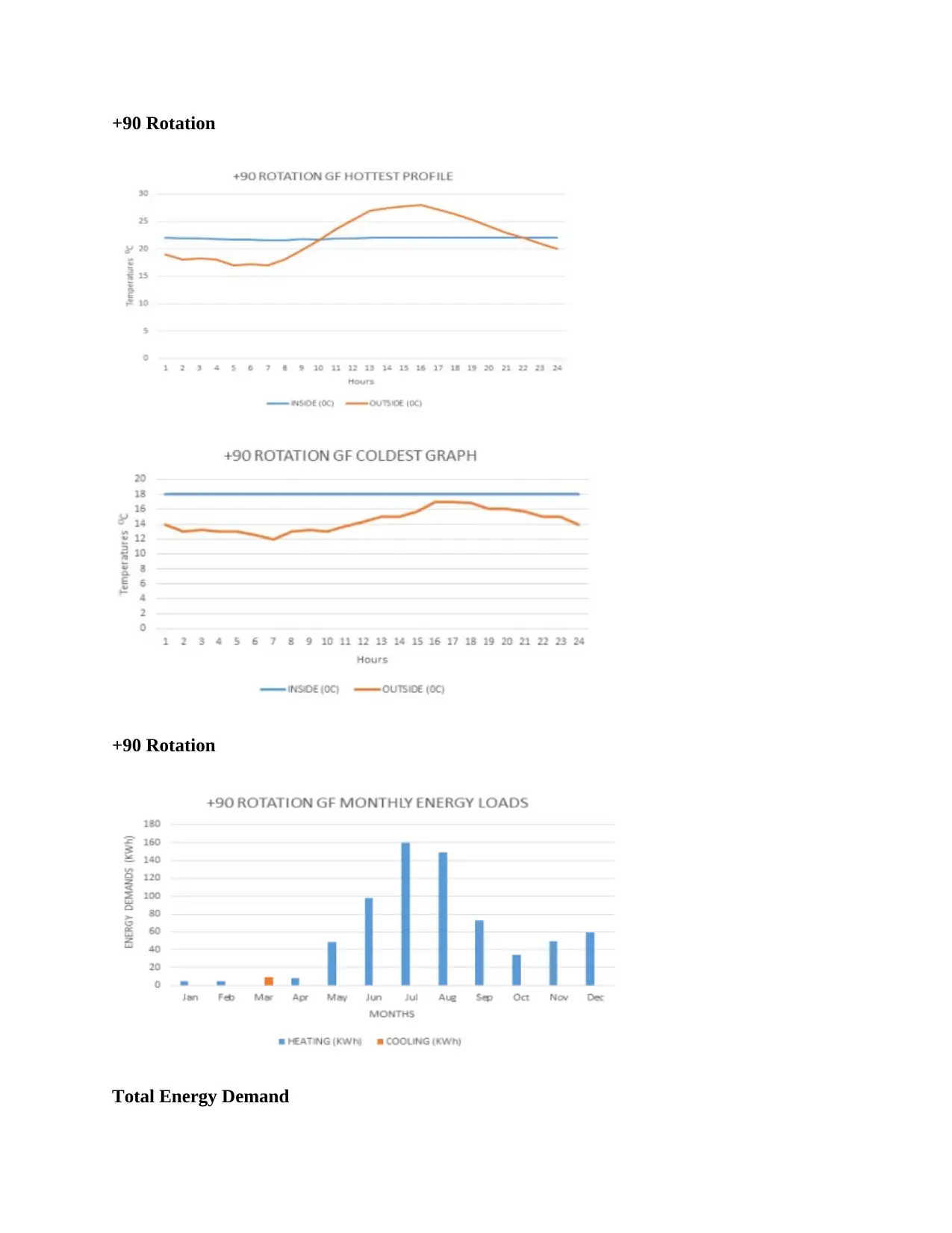
+90 Rotation
+90 Rotation
Total Energy Demand
+90 Rotation
Total Energy Demand
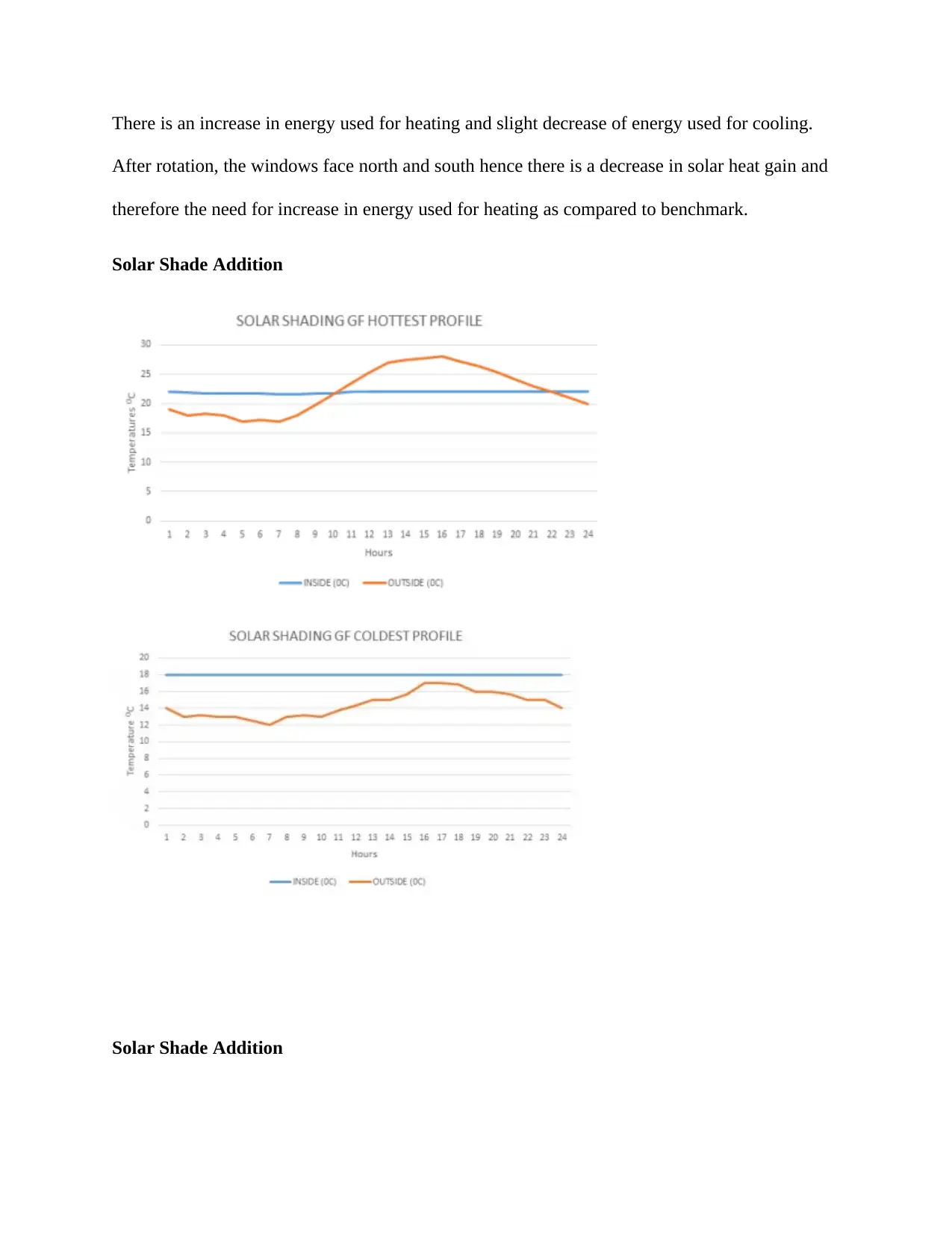
There is an increase in energy used for heating and slight decrease of energy used for cooling.
After rotation, the windows face north and south hence there is a decrease in solar heat gain and
therefore the need for increase in energy used for heating as compared to benchmark.
Solar Shade Addition
Solar Shade Addition
After rotation, the windows face north and south hence there is a decrease in solar heat gain and
therefore the need for increase in energy used for heating as compared to benchmark.
Solar Shade Addition
Solar Shade Addition
⊘ This is a preview!⊘
Do you want full access?
Subscribe today to unlock all pages.

Trusted by 1+ million students worldwide
1 out of 20
Your All-in-One AI-Powered Toolkit for Academic Success.
+13062052269
info@desklib.com
Available 24*7 on WhatsApp / Email
![[object Object]](/_next/static/media/star-bottom.7253800d.svg)
Unlock your academic potential
Copyright © 2020–2025 A2Z Services. All Rights Reserved. Developed and managed by ZUCOL.
